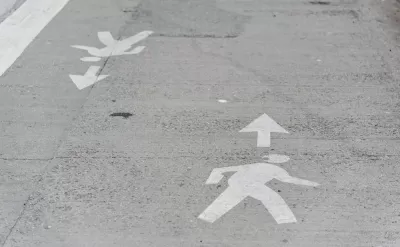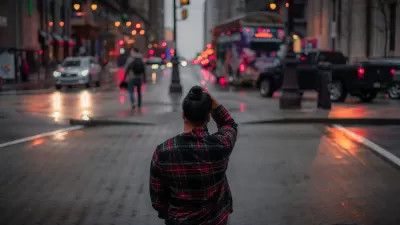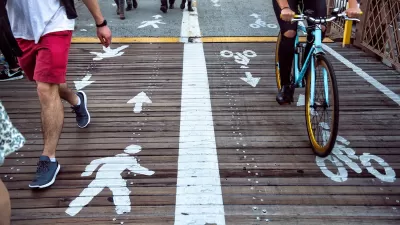At the ninth session of the World Urban Forum held earlier in Kuala Lumpur, Malaysia, the Institute for Transportation and Development Policy introduced their new "Pedestrian First" toolkit to measure and promote walkability in urban environments.

When it comes to mobility, most American municipalities place priority on the movement of private motor vehicles. The needs of transit vehicles, cyclists and pedestrians are secondary. Kuala Lumpur, the site of the Ninth session of the World Urban Forum held from Feb. 7 to Feb. 13, is not much different.
"Organised by UN-HABITAT every two years in a different city around the world, this forum [was] the first session that focuse[d] on the implementation of the New Urban Agenda," noted one of the local organizers, Think City. The forum is considered the "world's premier conference on cities."
“Walkability is not just a sidewalk - it’s a whole system of design and infrastructure,” Joe Chestnut of the Institute for Transportation and Development Policy (ITDP), a global think tank, told the Thomson Reuters Foundation on the sidelines of the World Urban Forum in the Malaysian capital this month, reported Gregory Scruggs on Feb. 15.
To help city officials tackle these challenges, Chestnut and his team designed a toolkit with 11 indicators for measuring how pedestrian-friendly a neighborhood is.
They include the number of pedestrian crossings, the size of blocks, the amount of shade and the density of driveways for cars.
Smaller blocks reduce walking distances and the need to make a dangerous mid-block crossing, as well as slowing down cars.
Scruggs compares some of the world's major cities to see how they rank in these walkability categories and also acknowledges two of the world's better recent developments that promote walkability.
On a busy street in downtown Kuala Lumpur, Chestnut pointed to pedestrian overpasses as infrastructure that appears to be designed for those who walk but more often inconveniences them while allowing cars to speed on through.
Kuala Lumpur is like any other big city,” said Neil Khor of Think City, a local government-backed urban regeneration agency. “It has a long way to go.”
Think City works with Malaysian cities to build pedestrian-friendly infrastructure, but Khor said the car still dominates.
Download the 75-page "Pedestrian First: Tools for a Walkable City." "With a better global understanding of walkability and more consistent and frequent measurement of the walkability of urban environments, decision-makers will be empowered to enact policies that create more walkable urban areas," according to ITDP.
“It is important that walkability isn’t a luxury (but) an essential component of equity and sustainability, particularly in the rapidly growing cities of the global south,” added Chestnut.
Hat tip to AASHTO Daily Transportation Update.
FULL STORY: How walkable is your city? Tool aims to make pedestrians safer and happier

Study: Maui’s Plan to Convert Vacation Rentals to Long-Term Housing Could Cause Nearly $1 Billion Economic Loss
The plan would reduce visitor accommodation by 25,% resulting in 1,900 jobs lost.

North Texas Transit Leaders Tout Benefits of TOD for Growing Region
At a summit focused on transit-oriented development, policymakers discussed how North Texas’ expanded light rail system can serve as a tool for economic growth.

Why Should We Subsidize Public Transportation?
Many public transit agencies face financial stress due to rising costs, declining fare revenue, and declining subsidies. Transit advocates must provide a strong business case for increasing public transit funding.

How to Make US Trains Faster
Changes to boarding platforms and a switch to electric trains could improve U.S. passenger rail service without the added cost of high-speed rail.

Columbia’s Revitalized ‘Loop’ Is a Hub for Local Entrepreneurs
A focus on small businesses is helping a commercial corridor in Columbia, Missouri thrive.

Invasive Insect Threatens Minnesota’s Ash Forests
The Emerald Ash Borer is a rapidly spreading invasive pest threatening Minnesota’s ash trees, and homeowners are encouraged to plant diverse replacement species, avoid moving ash firewood, and monitor for signs of infestation.
Urban Design for Planners 1: Software Tools
This six-course series explores essential urban design concepts using open source software and equips planners with the tools they need to participate fully in the urban design process.
Planning for Universal Design
Learn the tools for implementing Universal Design in planning regulations.
City of Santa Clarita
Ascent Environmental
Institute for Housing and Urban Development Studies (IHS)
City of Grandview
Harvard GSD Executive Education
Toledo-Lucas County Plan Commissions
Salt Lake City
NYU Wagner Graduate School of Public Service





























